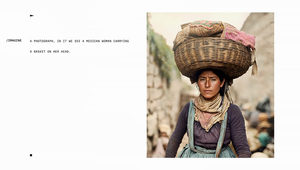
In an AI World, What Is a Canon Camera Worth?

A mainstay of photography for 90 years, Japanese brand Canon is refusing to be left in the past. A strong believer in technology as a link between innovation and human creativity, they partnered with Dentsu Creative Brazil for a campaign in the run-up to Black Friday.
'The Gaze Changes Everything' highlights how the human gaze and sensibility can work in conjunction with - not in opposition to - new AI imagery tools. Based on the concept that ‘without the click, there is no prompt’, the three films, social media content and a series of prints demonstrate how the best gen AI prompts are those that reference real photographers’ work.
Showing a sequence of AI images, and the prompts used to achieve them, the work demonstrates how AI alone cannot creatively surpass what the human eye is capable of. The campaign exalts the photography of Benjamin Abrahão Botto, Tina Modotti and Lewis Wickes Hine, and shows how these real world references are what shape creative ideas - and are vital for working with generative AI technologies.
LBB’s Ben Conway caught up with Pedro Reis, ECD at Dentsu Creative Brazil, to find out more.
LBB> Pedro, you’ve said this campaign “uses AI to highlight and enhance the power of the human eye in photography” - where did this idea come from? What was the brief?
Pedro> The brief called for a creative approach to drive interest in photography a few weeks before Black Friday. But in a world where AI now produces stunningly perfect images, how could we emphasise the value of Canon cameras? Observing our own use of AI as art directors, illustrators, and designers, we noticed that prompts rooted in real references produce more powerful, authentic images. This insight shaped the campaign, highlighting the importance of the human eye in enhancing and directing technology.
LBB> Why is it important for you and Canon to highlight human ability, in the context of advancing AI technologies?
Pedro> Technology, whether it's Canon’s advanced cameras or AI, is available to everyone. What truly makes a difference is how each individual uses it and the unique perspective they bring. So, it's essential to show that technology is just a tool - human skill is what transforms that tool into creativity.
LBB> How did you develop the film’s idea of increasingly descriptive AI prompts that eventually lead to a real photographer’s style?
Pedro> Using AI tools like Midjourney, a key aspect of creating an effective prompt is to precisely describe the desired photographic style. So, we described each image in detail and added the style of the chosen photographers. We used Midjourney to generate the images. We tested and refined the prompt within the AI, and the result is exactly what appears in the films. Once we reached the perfect prompt, we deconstructed the process step-by-step.
LBB> How was the process of writing prompts that gave you suitable imagery, but which would also read well as copy in the films and in the print ads?
Pedro> The prompts were developed in close collaboration between art directors and copywriters; the art directors described what they envisioned, while the writers refined the wording. It was a process of trial and error, and the final prompts in the films and ads are exactly the ones used in Midjourney to generate the images.

LBB> How did you select which photographers to showcase? Why were these three chosen?
Pedro> Canon is a brand aimed at photography enthusiasts. We wanted to avoid advertising clichés, and after extensive research, we chose three iconic photographers, known not only for their aesthetic but also for the social impact of their work. Lewis Hine was a pioneer in documentary photography, Tina Modotti captured Mexican culture and social struggle, and Benjamin Abrahão documented life within Brazil's cangaço movement.
LBB> The films don’t use music, only the sound of a keyboard - why is that?
Pedro> The films simulate the near real-time process between the prompt creator, the AI, and the photographic result. We wanted an intimate, minimalist approach, capturing the essence of real life. Additionally, by focusing on the sound of the keyboard, we allow the photography to take centre stage without any competing elements.

LBB> Who designed the posters? What were the key design choices that went into these?
Pedro> The design was created by the Dentsu Creative team, who opted for a simple aesthetic that emulated the AI creation process. We chose a monospace font, often used in coding, and constructed a sequence of images, highlighting the final portrait that best reflects the photographer’s style.
LBB> The campaign is ‘A tribute from Canon to all perspectives’. Was it difficult to find a balance between celebrating the human eye, while also not completely diminishing the power and potential of generative AI? How did you try to present both without them being in direct conflict with each other?
Pedro> It would be naïve to disparage AI, which has brought significant advancements and simplified our work. AI is even embedded within Canon itself, present in some products. For us, the human eye and AI complement each other. AI is a tool, but it’s the human eye that transforms it.
LBB> What was the hardest challenge you faced on this project? How did you overcome it?
Pedro> The biggest challenge was achieving the ideal prompt that closely resembled the photographers’ original images. It was a process of trial and error, much like what we encounter daily in our creative work.














